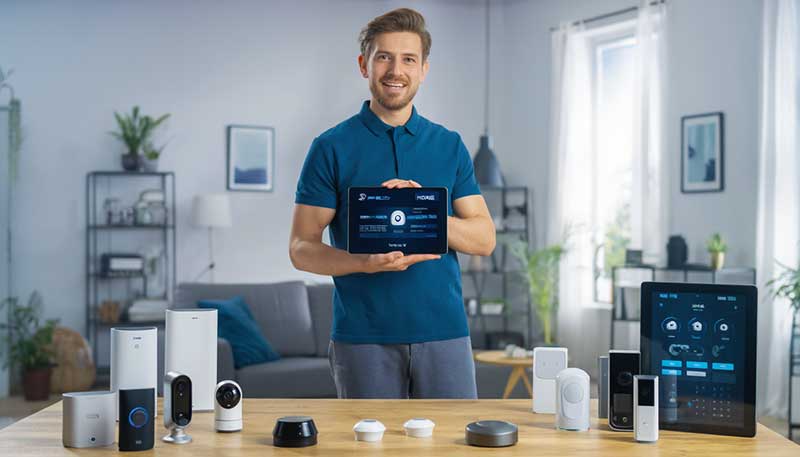Home ➢ Home Security Guide
The Complete Guide to Smart Home Security on a Budget

Home security doesn't have to break the bank. With smart technology becoming more affordable and accessible, you can create a comprehensive security system that rivals expensive professional installations—all while spending a fraction of the cost. The key is understanding which components provide the most security value and how to integrate them effectively.
Modern DIY smart security systems offer professional-grade protection with the convenience of easy installation and no monthly monitoring fees. By choosing the right combination of devices and implementing smart security strategies, you can protect your home, family, and belongings without the hefty price tag of traditional security companies.
Essential Components of Budget-Friendly Smart Security
Smart Video Doorbells: Your first line of defense starts at the front door. Smart doorbells with built-in cameras, two-way audio, and motion detection let you see and speak with visitors from anywhere. Many affordable options offer cloud storage and smartphone alerts, making them incredibly cost-effective security tools.
Window and Door Sensors: These small, inexpensive devices alert you immediately when doors or windows are opened unexpectedly. Battery-powered wireless sensors can be installed in minutes without any wiring, and they provide excellent perimeter protection for under $20 per sensor.
Motion Detection Cameras: Strategic placement of affordable security cameras in key areas provides visual confirmation of any activity. Look for cameras with night vision, smartphone alerts, and local storage options to avoid monthly cloud fees.
Smart Lighting for Security and Deterrence
Well-lit homes are significantly less likely to be targeted by burglars. Smart lighting systems can simulate occupancy when you're away, respond to motion detection, and provide automatic illumination of dark areas around your property.
Smart bulbs and switches can be programmed to follow realistic patterns—gradually dimming in the evening, turning on different rooms at various times, and responding to your actual schedule. Motion-activated outdoor lighting serves as both a deterrent and an early warning system for approaching visitors.
Creating Comprehensive Coverage on a Budget
Start with the most vulnerable entry points: front door, back door, and any ground-floor windows that provide easy access. A basic system might include a smart doorbell, 4-6 door/window sensors, and 2-3 indoor cameras placed strategically to monitor main living areas.
Expand your system gradually as budget allows. Add outdoor cameras for perimeter monitoring, smart locks for keyless entry and remote access control, and environmental sensors that detect smoke, carbon monoxide, or water leaks.
Professional Monitoring vs. Self-Monitoring
Many budget-conscious homeowners choose self-monitoring systems that send alerts directly to their smartphones rather than paying monthly fees for professional monitoring services. With self-monitoring, you receive instant notifications and can assess situations in real-time using live camera feeds.
For those who prefer professional backup, several companies offer affordable monitoring services for DIY systems, typically costing $10-20 per month compared to $40-60 for traditional systems.
Integration and Automation for Maximum Effectiveness
The power of smart security lies in integration. When motion is detected by an outdoor camera, the system can automatically turn on lights, start recording on multiple cameras, and send smartphone alerts with live video feeds. This coordinated response provides better security than individual devices working in isolation.
Smart home platforms like Samsung SmartThings, Amazon Alexa, or Google Home can serve as central hubs, allowing different brand devices to work together seamlessly and enabling complex automation routines that enhance security.
Installation Tips and Best Practices
Most modern smart security devices are designed for easy DIY installation. Wireless sensors typically use adhesive mounting or simple screws, while cameras often include magnetic mounts for flexible positioning. Always test devices before final mounting and ensure strong Wi-Fi signal strength at installation locations.
Position cameras to avoid privacy concerns for neighbors while maximizing coverage of your property. Use weatherproof enclosures for outdoor devices and consider battery backup for essential components in case of power outages.
Maximizing Security ROI
Focus your budget on devices that provide multiple security benefits. A smart doorbell serves as both a deterrent and detection device. Motion-sensing smart lights provide security, convenience, and energy savings. Door/window sensors offer the most comprehensive perimeter protection for the lowest cost per entry point.
Remember that visible security measures often deter crime more effectively than hidden ones. Security system decals, visible cameras, and smart doorbells signal to potential intruders that your home is protected, often preventing incidents before they occur.
Share this article:
React to this article: